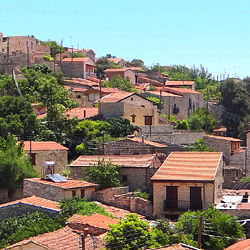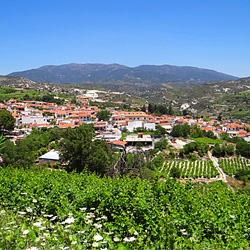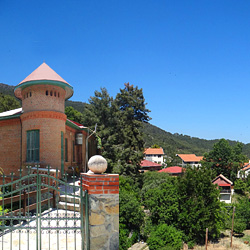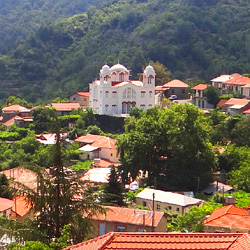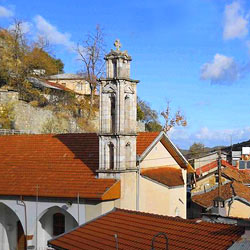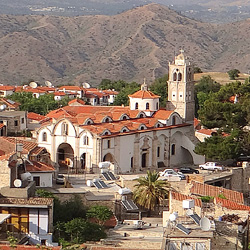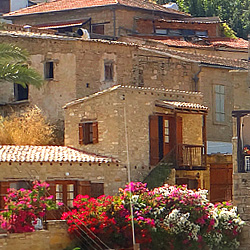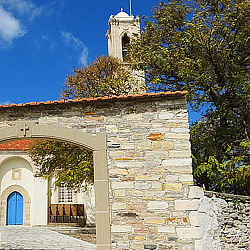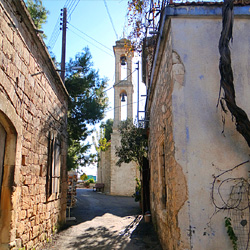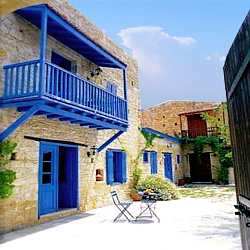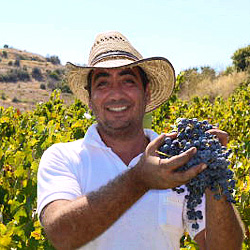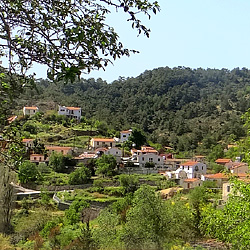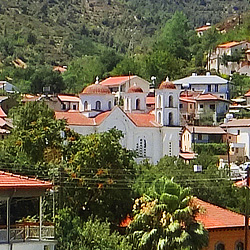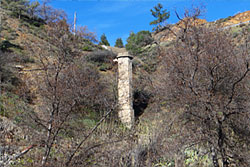
Kakopetria Old Power Station
The Kakopetria power station began its operation at the beginning of the 20th century specifically in 1926 due to the initiative of Christos Vasiliou, a resident of the village. The source of energy of the power station was water, giving it a special place in the history of electricity in Cyprus.
The creation of hydro-electricity in Kakopetria and the personal endeavours of Vasiliou are related to one another. Vasiliou managed to succeed in founding the power station, mainly due to his devotion to power the village, rather than to his knowledge of the matter. His knowledge was limited to the small power generating plant which he used at his job in the Amiantos mines. In 1926, having returned from the Amiantos mine, with his wife by his side, he made an attempt to put into motion the power station project something that at the time seemed nearly impossible. It was then when Christos and his wife Orthodoxia decided to sell all their property to achieve their goal which was to purchase a part of church land on the banks of the Klariou River, namely Karkoti or otherwise known as the Kappadoukas area. This was to be the place where the couple’s dream with come true. After hard work, they managed to initially construct a wooden tower which was later replaced by a concrete structure having first completed a series of necessary tests. The project was finally completed in mid September of 1927.
According to the son of the Vasiliou couple, the hydroelectric power station had the following structure: It was composed by a tower (50 meters) with an opening of around 2 meters. The tower was joined with a concrete channel. Water ran through this channel into the hole causing the runner to begin functioning. The runner then activated the machine which ultimately provided the electric power.
When the power station was finally in a position to offer its services to the community, some “electrical installations” started taking place in a few homes. The houses were connected to the power station via cables which passed through logs. Each house which requested electricity, had one lamp, and the cost to the house-owners was two shillings per month. Supply of electricity was now feasible, and on the evening of the 17th September 1927, the residents all gathered in the central square of Kakopetria to see and admire the new power station which was accomplished after the hard work and countless efforts of the Vasiliou couple. That night, as the runner began working and the village was illuminated, people of the village witnessed an important event for the history of the entire island. The power station of Kakopetria, which used water as the main source of electric power, was the first one of its kind on the island.
During the first years of the establishment of the power station, people were very dubious about Vasiliou’s achievement to the point that they even hindered its operation. It is notable that at the time on thirty houses had been connected to the grid. Even more notable was the fact that often the main source of the station’s energy, the water, was diverted with the excuse that it was needed for agricultural usage.
At the beginnings of the operation of the power station, it worked for restricted hours always according to the flow of water. For example, during winter, the power station produced electric power till one o’clock in the afternoon and during summer for fewer hours, due to the lack of water supply. It was not possible to operate, as we mentioned above, when the farmers diverted the flow of the water to their plantations.
Despite all these obstacles, Christos Vasiliou managed to impart his passion and knowledge to his son Andreas. In 1947, Andreas had become an expert in electrical installations, according to the pertinent regulations of the department of Public Works. Thanks to the new know-how and the increased needs of the village, the installations have expanded and diesel engines were bought and installed. The operation of the cinema “Orpheas” was also due to the efforts of Christos Vasiliou.
The use of diesel engines for the production of electric power gradually expanded in the village and for a short period of time both the diesel engines and the power station operated together to cover the needs of the community. The diesel engines functioned during summer, when the quantity of water was reduced, and the power station functioned during winter.
The provision of electric power became an obligation of the government some years later and Christos Vasiliou, known as the “Electrician of Kakopetria”, was no longer responsible for powering the village but it was now the state’s responsibility.
Nowadays, the Electricity Authority of Cyprus is cooperating with the Community Council of Kakopetria and is trying to restore the hydroelectric power station of the area. They are replacing various mechanical parts of the station to make it functional with the intent of converting it into a museum.
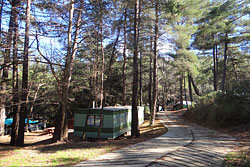
Platania Picnic and Camping Site
If you're an outdoor lover, then you probably like camping. It's the best way to experience the great outdoors.
Platania campsite in the forest has 18 toilet/shower blocks with kitchen facilities as well as disabled facilities and picnic tables. There are kids' play areas and near the campsite there is a canteen selling most kiosk type products. Located 5km from the village of Kakopetria near the Platania forest station.
Price: €5 per night for two people.
Tel: 22924225.
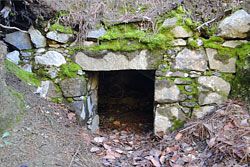
EOKA Hideouts
The guerilla fighters of EOKA built their hideouts at the mountain slopes of Kakopetria which are covered by dense and wild vegetation.
The hideouts were spread along the mountain slope. The book of Charalambos Ar. Charalambides transfers us to the slopes of the mountain of Kakopetria, where the guerilla fighters found shelter during the harsh moments of the fights against the British. Presented below are some of the hideouts hosted by the land of Kakopetria, the criteria for the selection of the area, as well as the way these hideouts were built.
One of the hideouts was built at the location “Vrysi” of the “Piteron” peak and was accessed by the fighters through a wild uphill trail, whereas a second hideout was located northeast of the church of Agios Nicolaos Stegis, at the location “Shiaka”. The hideout was covered by wild vegetation and situated “near a narrow trail leading towards the river” (p.260). At this location, as Charalambides preserves through the words of sector leader named Lemonaris, there were several kinds of wild vegetation. Lemonaris describes the area where the hideout was built as wild and adds that the hideout was located on the left bank of the river, near the earthen trail leading towards the chromium mine and Marathassa.
Another hideout was built at the valley of the Karkotis River, at the location “Giampakka” situtated across the “pezounokremmos” cliff and in a dense forest. This particular location was chosen due to the dense forest, the river bed which could be used both as a natural fortress since it covered a large area and in order to provide the fighters with water. Apart from the attention given to the selection of the location for the construction of the hideout, great emphasis was also given while carrying the construction materials, such as timber, as well as the food for the supply of the guerilla fighters.
Upon completion of constructing a hideout, the guerilla fighters would make sure that their traces were erased, either by covering everything with dirt or by using leaves and branches. What is characteristically mentioned about the aforementioned hideout, “which was placed in the middle of a bush, is that it was completed within a few days by the guerilla fighters using logs from the surrounding bushes. The area surrounding the hideout was camouflaged using dry leaves and branches leaving no trace of dug dirt or misplaced object” (p.290).
As it is evident by the aforementioned, the selection of the location for the construction of the hideouts was of extreme importance. In particular, Charalambides presents a list of advantages regarding the construction of a hideout at the river mouth of the River Choletrous-Agios Georgios, through what Lemonaris had written about the matter. A first advantage was the fact that the area was wild and overgrown and consequently ideal for coverage, whereas it could only be accessed through climbing. However, in case the fighters needed to escape, this would be easy since it could be done through the river bed. Moreover, the area was close to the village and therefore the fighters could easily receive supplies, whereas this proximity did not pose any danger since “no one would go near the area” (p.318). Additionally, the water from the river erased any traces since the dirt would fall into the river. Finally, the fighters could easily be supplied with water in case of an emergency.
Undoubtedly, the land of Kakopetria protected the guerilla fighters of EOKA who fought against the British with militancy and boldness.

Panayiotis Toumazou & Alekos Kostantinou Statue
The community of Kakopetria honors the fighter Panayiotis Toumazou with a monument built on the spot where he was killed.
Panayiotis Toumazou died during a fight with English soldiers having in his pocket the emblem of peace.
The unveiling of the monument took place in 23 June 1993 by the minister of Agriculture and Natural Resources, Giorgos Petridis. The monument is built on the road of Nicosia-Troodos and more specific in the area of “Saranta Mili”.
His life
Panayiotis Toumazou is one among a big list of people who died during the English Occupation.
His parents were Theofilos and Artemisia Toumazou. He was born on 12 July 1939 in Famagusta. He had 6 sisters: Kiriakoula, Evi, Androula, Eleftheria, Irene, Despina, and 5 brothers: George, Ellinas, Nikolas, Kostantinos and Pavlos.His first school was the elementary school of Famagusta and later on he went to the Greek gymnasium.
After he had finished school, he worked for a short time as a customs broker. Then he had completely stopped working, and he was dedicated to the national war against the English troops.
Panayiotis Toumazou was a member of a group which was organized in order to fight against the English troops. This group included many known members of the national war such as Petrakis Yialouros and many others.The group of Panayiotis Toumazou cooperated with the group of the commerce school of Famagusta. The common goal of the two groups was the transmission of the Greek ideals and dreams and the provocation of casualties in the English army.Panayiotis Toumazou was responsible for the distribution of leaflets concerning the goals of the national war and for the writing of slogans. His passion guided him to involve in force groups and ambushes. In December of 1955, Panayiotis Toumazou took part in the successful operation for the blow up of a vehicle of the English army.
The young fighter, participated in an attack against a Turk spy, after an order of EOKA. Toumazou and another fighter organized the attack which took place ion 20 July 1958.
After this attack, Toumazou became a fugitive for the English authorities. Thus, he decided to leave the area and recruit the group of rebel fighters “Onisilos”, in Solea.
Antonakis Solomontos, was a partner of Toumazou, who narrated many stories for the life of Toumazou after his death. One of them says that some fighters have set an ambush in the road of Kakopetria-Karvouna, and stayed there for thirteen nights until they managed to attack the English troops.
The last night, Panayiotis Toumazou had cut a branch of an olive tree, and said to the others “if I die tonight, the English will find the branch and they will understand that I am fighting for peace”.
That night, Panayiotis Toumazou, Antonakis Solomontos and Andreas Aggeli saw two big vehicles full of English soldiers passing by. They instantly began shooting.
Panayiotis Toumazou activated a mine in order to stop the vehicles, but unfortunately the mine didn’t work. Then, he threw a hand grenade but at the same time an English soldier shot him on his head.
His death was instant. Antonakis Solomontos tried to carry him away, but due to the big fire he didn’t make it. Panayiotis Toumazou, remained there, having the emblem of peace in his pocket.
Alekos Kostantinou
Alekos Kostantinou was born in Kakopetria, on the 6th October 1936. His parents were Kostas and Elpiniki Kostantinou. Alekos was an only child.
He lived in Famagusta where he went to the elementary school of the town and then he continued on to the gymnasium followed by the Commerce school.
From the beginning of the National war, Alekos Kostantinou became a member of the executive group of Famagusta. His home was the safest refuge for the fighters of EOKA because the English believed that he was very reliable. Alekos and his mother agreed to keep in their home all the guns of their group. In order to deceive the English, he invited them very often in his house. Thus, they never believed that he could fight against them. Alekos Kostantinou was an active member of EOKA till the end of the war. He organized an ambush, on April 1958, with many other members of EOKA, near the cinema “Iraio” where they shot the most aggressive and tough English inquisitor, Dear. The killing of Dear was one of the most important victories of EOKA.
Some minutes before Dear’s death, he managed to whisper to his soldiers, the names of his killers. The two soldiers run after them but the two fighters hid in the cinema. Alekos Kostantinou with his co-fighter decided to leave the area because they knew that the English troops would not stop seeking. Alekos and Panayiotis Georgiadis went to Kourdali in order to meet Kostas Patsalidis and Panayiotis Georgiadis and set up an ambush against the English. Unfortunately the mine exploded before the right time and killed Alekos Kostantinou on the 20th June 1958.
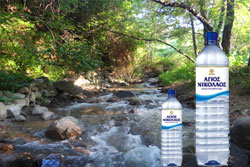
Agios Nikolaos Water Company
Set near the village of Kakopetria, in the heart of Troodos Mountains, a mineral water plant has been designed and built to the highest European standards at the Saint Nicholas source.
The remarkable purity of SAINT NICHOLAS water is owed both to the location of the source far from residential or polluted areas and to the bottling procedure of the water in environmentally friendly P.E.T. bottles produced on site prior to filling.
In a reaserch study carried out by the National Center of Science Research "DEMOCRITOS" (Athens, Greece), the water from the Saint Nicholas source was found to be at least 370 years old...! Ageing long before any possible contamination caused by human activity related to environment pollution.
In April 2000, the European Union officially certified SAINT NICHOLAS a Natural Mineral Water.
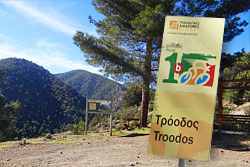
Cycling Routes
Follow the Troodos cycling routes or even make your own. Set the pace you desire whether training or leisure and fill your lungs with fresh air while doing your bit to fight global warming and protect the environment.
- 1
- 2

